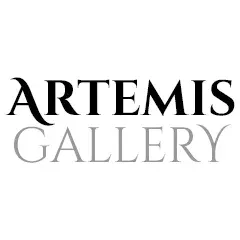







Greek Apulian Pottery Bell Krater – Eros & Maenad
Winning Bid: $3,000
Magna Graecia, South Italy, Apulian, ca. 330 BCE. A wonderful red-figure bell krater, finely decorated via the red-figure technique. Side A features a winged Eros holding a mirror and a ribboned tympanum. Side B presents a lovely maenad, dressed in a flowing chiton and adorned with a necklace and bracelets, her head in profile with delicate features topped by an updo coiffure, sitting upon a pile of rocks and holding a caskette in her left hand and a floral sprig in her right hand – with many of its details delineated in fugitive white and yellow pigment. Size: 8.75″ W x 9″ H (22.2 cm x 22.9 cm)
Contributing even more to the decorative program is the laurel leaf garland adorning the underside of the flared rim, a band of running wave motifs below the figures, and composite palmettes below the handles.
Perhaps the most exciting innovation in Greek vase painting was the red-figure technique, invented in Athens around 525 BCE and beloved by other artists of Magna Graecia. The red-figure technique allowed for much greater flexibility as opposed to the black-figure technique, for now the artist could use a soft, pliable brush rather than a rigid metal graver to delineate interior details, play with the thickness of the lines, as well as build up or dilute glazes to create chromatic effects. The painter would create figures by outlining them in the natural red of the vase, and then enrich these figural forms with black lines to suggest volume, at times perspectival depth, and movement, bringing those silhouettes and their environs to life. Beyond this, fugitive pigments made it possible for the artist to create additional layers of interest and detail as we see in this example.

